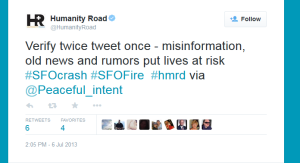“Verify twice, tweet once” is a mantra continually hammered home whenever quickly evolving, controversial or incredulous situations breaks on social media. But, an unsettling New York Times piece published yesterday reveals new challenges in “verifying twice”, and should be required reading for all communications managers responsible for monitoring social media channels during crisis.
Trust me, I’m no Bob Woodward, having repeated/retweeted bum information over my social media feeds. My gullibility and complacency made me an unwitting accomplice, sharing stories and statements that played on my emotions (especially stories of revenge or happy endings). After being called out a few times I’ve learned a cynical approach to checking a stories veracity. Snopes.com is now my first stop when my internal b#$%&t meter starts beeping. I also look for corroborating links, tweets, videos and still photos from multiple sources before repeating. (Full disclosure alert; I still occasionally get caught, mostly due to laziness and the seductive nature of wanting to be one of the first to spread a breaking story – something Chuck Todd learned the hard way a couple of years ago).
While I’m not naive enough to think that this is a new concept in government propaganda, I think the Times story should send shivers down the spines of all emergency managers, crisis communicators (public or private), public officials and CEO’s. Agencies and companies are now subject not only to local and national bloggers with personal agendas, but also to sophisticated international social media attacks appearing as legit stories shared through legit sources, a form of “Twerorrism”. The intensity and depth of the reporter’s investigation, and subsequent retaliation by “The Agency” is a sobering reminder of the dangers and depth of digital propaganda, especially by organizations and governments with deep pockets.
How do we combat “twerorrism”? Some simple grassroots suggestions;
- Start with the proverbial- If it sounds to good (or bad) to be true, it probably is.
- Look for corroborating information from your legitimate and trusted sources.
- Ask around. Check with others you trust.
- Dig into the background of the sources sharing the information. How many followers do they have? Who are their followers? What, if any, words/patterns/agendas strike you in their previous posts?
- Images often accompany false information in an attempt to add credibility. Google reverse image search is a quick initial way to check for an image hoax. You can find the instructions here. Instructions on using Google Reverse Image Search
- Slow down. Do you really need to share a stranger’s “breaking news”? Remember, if you are an SMEM’er worth your salt, you have a network of trusted folks who may assume the info you are sharing is legit. The re-sharing of bad information by your legitimate followers will likely undermine your credibility.
- Correct it NOW! If you unknowingly share bad information, and (hopefully) soon thereafter discover the information is false, send out a public correction ASAP!
- Don’t ever assume deleting your incorrect tweet will make the problem go away. You’ll never be faster than someone with a screen capture tool.
Read and discuss the NYT article with your staff, focusing on the layers of sophistication in integrating and linking various social media platforms with false personal accounts. Let’s hope our principles of free speech and expression serve as the most effective defense of all.
 It's Not My Emergency Retired Crisis Manager's Brain Dump
It's Not My Emergency Retired Crisis Manager's Brain Dump
